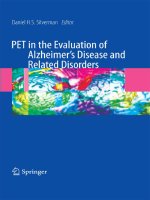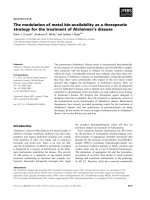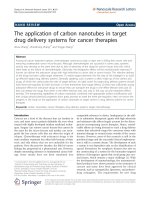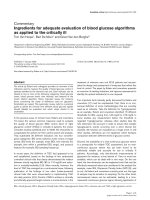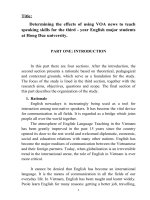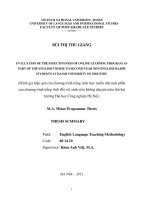The evaluation of bioactive polycaprolactone scaffolds as protein delivery systems for bone engineering applications
Bạn đang xem bản rút gọn của tài liệu. Xem và tải ngay bản đầy đủ của tài liệu tại đây (18.71 MB, 216 trang )
1
THE EVALUATION OF BIOACTIVE POLYCAPROLACTONE
SCAFFOLDS AS PROTEIN DELIVERY SYSTEMS FOR BONE
ENGINEERING APPLICATIONS
BINA RAI
(B. Sci. (Hons), NUS)
A THESIS SUBMITTED
FOR THE DEGREE OF DOCTOR OF PHILOSOPHY
DEPARTMENT OF ORAL & MAXILLOFACIAL SURGERY
NATIONAL UNIVERSITY OF SINGAPORE
2006
2
PREFACE
The thesis is submitted for the degree of Doctor of Philosophy in the Department of Oral
& Maxillofacial Surgery at the National University of Singapore under the supervision of
Associate Professor Ho Kee Hai and Professor Teoh Swee Hin. No part of this thesis has
been submitted for other degree at other university or institution. To the author’s best
knowledge, all the work presented in this thesis is original unless reference is made to
other works. Parts of this thesis have been published or presented in the following:
INTERNATIONAL JOURNAL PUBLICATIONS
1. B. Rai
, S.H. Teoh, D.W. Hutmacher, T. Cao, F. Chen, K. Yacob and K.H. Ho. The
effect of rhBMP-2 on canine osteoblasts seeded onto 3D bioactive polycaprolactone
scaffolds. Biomaterials 2004; 25(24): 5499-5506.
2. B. Rai, S.H. Teoh, D.W. Hutmacher, T. Cao and K.H. Ho. Novel PCL-based
honeycomb scaffolds as drug delivery systems for rhBMP-2. Biomaterials 2005; 26(17):
3739-3748.
3. B. Rai, S.H. Teoh and K.H. Ho. An in vitro evaluation of PCL-TCP composites as
delivery systems for platelet-rich plasma. Journal of Controlled Release 2005; 107(2):
330-342.
4. Y. Lei, B. Rai, K.H. Ho and S.H. Teoh. In vitro degradation of novel bioactive
polycaprolactone-20 % tricalcium phosphate composites for bone engineering. Accepted
with minor revision by Journal of Material Science and Engineering.
5. B. Rai, M.E. Oest, K.M. Dupont, K.H. Ho, S.H. Teoh, R.E. Guldberg. Platelet-rich
plasma delivery on 3D polycaprolactone-tricalcium phosphate scaffolds promotes early
vascularization during segmental bone repair. Submitted to Journal of Material Research.
6. B. Rai, Y. Lei, K.M. Si-Hoe, K.B. Yacob, F. Chen, S.H. Teoh, K.H. Ho. Three
dimensional polycaprolactone- tricalcium phosphate scaffolds loaded with platelet-rich
plasma facilitates the placement of dental implants and induces mandibular bone
regeneration simultaneously. Submitted to Journal of Oral and Maxillofacial Surgery.
3
CONFERENCE PAPERS
1. B. Rai, S.H. Teoh, D.W. Hutmacher, F. Chen, K. Yacob, C. Tong and K.H. Ho.
The effect of rhBMP-2 on canine osteoblasts seeded onto 3D bioactive polycaprolactone
scaffolds. 7
th
World Biomaterials Congress, Symposium 30: Developing New
Biomaterials: the Composite Approach, 17-21 May 2004, Sydney, Australia.
2. B. Rai, S.H. Teoh, D.W. Hutmacher, T. Cao and K.H. Ho. Novel PCL-based
honeycomb scaffolds as drug delivery systems for rhBMP-2. Joint Meeting of Tissue
Engineering Society International & European Tissue Engineering Society, 10-13
October 2004, Lausanne, Switzerland.
3. B. Rai, S.H. Teoh and K.H. Ho. An evaluation of PCL-TCP composites as delivery
systems for platelet-rich plasma. Regenerate Conference, 1-3
June 2005, Georgia, USA.
4. Y. Lei, B. Rai, K.H. Ho and S.H. Teoh. In vitro degradation of novel bioactive
polycaprolactone-20 % tricalcium phosphate composites for bone engineering.
International Conference on Materials for Advanced Technologies, 4-8 July 2005,
Singapore.
5. B. Rai, M.E. Oest, K.M. Dupont, K.H. Ho, S.H. Teoh, R.E. Guldberg. Platelet-rich
plasma delivery on 3D polycaprolactone-tricalcium phosphate scaffolds promotes early
vascularization during segmental bone repair. 8
th
TESI Annual Meeting, 22-25 October
2005, Shanghai, China.
6. B. Rai, M.E. Oest, K.M. Dupont, K.H. Ho, S.H. Teoh, R.E. Guldberg. Platelet-rich
plasma delivery on 3D polycaprolactone-tricalcium phosphate scaffolds promotes early
vascularization during segmental bone repair. The 12
th
International Conference on
Biomedical Engineering, 7-10 December 2005, Singapore.
4
ACKNOWLEDGEMENTS
The author would like to thank Professor Teoh Swee Hin and Associate Professor Ho
Kee Hai for all their guidance, complete trust and belief in her capabilities. She especially
appreciates the freedom entrusted to her in making major decisions and in steering the
direction of her project. She hopes she has fulfilled Professor Teoh’s criteria for a true
researcher, one who has “content, character and contact”.
She is extremely grateful to Associate Professor Cao Tong and his team from the
Dentistry Research Lab and Associate Professor Dietmar Hutmacher and his group from
the Tissue Engineering Lab. She also immensely thanks Associate Professor Robert
Guldberg and his team over at the Georgia Institute of Technology for providing her the
opportunity of an enriching overseas experience.
She acknowledges her family, in particular her mother, Madam Pushpa Devi, for all her
sacrifices, for always being there and for pushing her to strive for excellence. She thanks
her bosom friends for being so kind and understanding during this stressful period. Most
importantly, she thanks god for blessing her with this amazing accomplishment. “Thank
you God for the ocean, when all I asked for was some rain”.
5
SUMMARY
The research scope encompasses the creation of novel bioactive composite scaffolds
consisting of polycaprolactone (PCL) physically blended with 20 % tricalcium phosphate
(TCP) particles. The supposition was for these scaffolds to be superior bone substitutes
than the first generation pure PCL scaffolds due to its likeness to the living bone in terms
of its composition. An additional perception was for these scaffolds to serve
simultaneously as protein delivery systems to further augment its bone regenerative
capacity. After the formulation of the concept and fabrication process, the scaffolds were
subjected to both in vitro and in vivo experiments to test their efficacy. The scope of this
thesis ended with animal studies, a stage just before preclinical trials.
PCL-TCP scaffolds loaded with osteoblasts sustained osteogenic expression in vitro. The
osteoblasts readily colonized the surfaces, rods and pores of the scaffolds while
maintaining their osteogenic phenotype for four weeks. The addition of recombinant
human bone morphogenetic protein-2 (rhBMP-2) enhanced the differentiated function of
these osteoblasts that resulted in accelerated mineralization, followed by their death as
they underwent terminal differentiation. Hence, the scaffolds were (1) capable of
facilitating the process from cellular attachment to differentiation to mineral, (2) not toxic
to the cells and (3) its 3D-architecture and porosity allowed for the infiltration of cells
and loading of proteins.
The protein release profile is a function of the degradation of the scaffolds. The objective
was to characterize the in vitro degradation behavior of PCL-TCP scaffolds, paying
special attention to how the inclusion of TCP would affect the degradation properties.
Based on weight loss, water uptake and pH measurements, it was found that PCL-TCP
6
scaffolds were degraded slowly in phosphate buffered saline (PBS). A calcium-rich layer
was nucleated on the scaffold’s surface that finally resulted in hydroxyapatite
precipitation after 2 weeks of immersion in simulated body fluid (SBF) as verified by X-
ray diffraction, scanning electron microscopy and biochemical analysis.
The effectiveness of PCL-TCP scaffolds as protein delivery systems for a single
osteoinductive factor was evaluated. Pure PCL scaffolds of similar architecture were
adopted as controls to investigate if the addition of TCP resulted in disparate release
profiles. Protein retention was 49.1 % ± for PCL-TCP scaffolds. The scaffolds were
loaded with rhBMP-2 in fibrin sealant and immersed in PBS for 4 weeks. The rhBMP-2
particles were distributed uniformly on the rods’ surfaces of PCL-TCP scaffolds. Bi- and
tri-phasic burst-like release profiles were observed for scaffolds loaded with 10 and 20
µg/ml rhBMP-2 respectively. PCL-TCP scaffolds retained rhBMP-2 longer than pure
PCL scaffolds. The stability and bioactivity of eluted proteins were verified as well to
ensure that the released growth factor could still execute its primary function of
stimulating tissue regeneration.
To evaluate the efficacy of the scaffolds as delivery systems for multiple
growth factors, platelet-rich plasma (PRP) was used. The buffers sufficed as
important determinants of the release profiles obtained for transforming growth factor
and platelet derived growth factor. PBS-soaked scaffolds manifested a tri-phasic burst-
like profile that was absent in SBF. SBF-soaked scaffolds showed sustained release of the
growth factors and total release was not achieved, whereas total release was realized for
PBS-soaked scaffolds. Only release profiles for SBF-soaked scaffolds were growth factor
mediated in terms of their amounts and sizes. The ultimate goal of obtaining the
7
release profile of growth factors was to correlate the protein release to the
stages of bone regeneration observed from subsequent in vivo studies.
We hypothesized that delivery of autologous PRP within a structural scaffold would
promote more rapid early revascularization of the defect region and enhance longer-term
functional bone repair. To test this hypothesis, we quantified the effects of PRP delivery
within PCL-TCP scaffolds on vascularization, mineralization, and mechanical properties
of large segmental defects in the rat femur. The in vivo study demonstrated that (1) PCL-
TCP scaffolds were effective at promoting bone formation within critically-sized femoral
defects, (2) PRP delivery promoted early vascularization within bone repair constructs,
and (3) micro-CT imaging techniques may be used to evaluate both vascularization and
mineralization in a challenging in vivo test bed of bone regeneration strategies.
The application of our bone regenerative strategy to a canine model and for a longer-term
period was investigated. The research showed that PRP loaded PCL-TCP scaffolds could
facilitate the placement of dental implants, shorten wound healing time and stimulate
mandibular bone regeneration simultaneously in mongrels. PRP-treated defects had 98.3
and 58.3 % higher bone volume than controls at 6 and 9 months respectively. New bone
trabeculae were observed in close apposition to the dental implants and penetrated the
defect site. The scaffolds experienced 33 % degradation from 6 to 9 months, finally
occupying only 46.9 % of the cross-sectional area.
In conclusion, the work presented in the thesis showed for the first time that three-
dimensional, bioactive polycaprolactone scaffolds can serve effectively as protein
delivery systems for bone regeneration and has the potential for clinical applications.
8
Table of Contents
PREFACE
i
ACKNOWLEDGEMENTS
iii
SUMMARY
iv
TABLE OF CONTENTS
vii
LIST OF FIGURES
xv
LIST OF TABLES
xxii
CHAPTER 1
INTRODUCTION
1.1 BACKGROUND 1
1.1.1 Current treatments for bone defects 1
1.1.2 Bone tissue engineering strategies 2
1.2 RESEARCH OBJECTIVES 5
1.3 RESEARCH SCOPE 6
CHAPTER 2
LITERATURE REVIEW
2.1 BONE PHYSIOLOGY 7
2.2 BIOMATERIALS SELECTION
12
2.2.1 Polycaprolactone (PCL)-based scaffolds 12
2.2.2 Rational for composite biomaterials 17
2.2.3 Fibrin tisseel sealant biomatrix technology 19
9
2.2.4 Recombinant bone morphogenetic protein-2 21
2.2.5 Platelet-rich plasma 24
2.2.6 Dental implants 28
CHAPTER 3
PROPOSED RESEARCH PROGRAM
3.1 RESEARCH OBJECTIVES 30
3.2 MILESTONE CHART 34
CHAPTER 4
CYTOCOMPATIBILITY AND BIODEGRADATION OF PCL-TCP SCAFFOLDS
4.1 INTRODUCTION 36
4.2 MATERIALS AND METHODS 37
4.2.1 Scaffold design and fabrication 37
4.2.2 Porosity calculation 38
4.2.3 Bone morphogenetic protein-2 38
4.2.4 Cytocompatibility study 40
Dog osteoblast culture and cell seeding on PCL-TCP scaffold 40
Cellular viability and proliferation assays 41
Cellular adhesion assay 42
Extracellular matrix production 42
4.2.5 Biodegradation study 43
Water uptake 43
10
Weight loss 44
pH measurements 44
4.2.6 Bioactivity study 44
Scanning electron microscopy 44
X-ray diffraction analysis 44
Von Kossa staining 45
Ionised calcium and phosphate concentrations 45
4.2.7 Statistical analysis 45
4.3 RESULTS 45
4.3.1 Scaffold morphology 45
4.3.2 Cytocompatibility study 45
Cellular viability and proliferation 45
Cellular adhesion 49
Extracellular matrix production 50
4.3.3 Biodegradation study 52
Water uptake 52
Weight Loss 53
Ph measurements 54
Bioactivity study 54
4.4 DISCUSSION 56
4.4.1 Cytocompatibility 56
Effect of rhBMP-2 on cell proliferation 56
Effect of rhBMP-2 on cell differentiation 60
11
4.4.2 Biodegradation 61
Water uptake 61
Weight Loss 62
Bioactivity 64
4.5 CONCLUSIONS 66
CHAPTER 5
PCL-TCP SCAFFOLDS AS PROTEIN DELIVERY SYSTEMS FOR RHBMP-2
5.1 INTRODUCTION 67
5.2 MATERIALS AND METHODS 69
5.2.1 Scaffold design and fabrication 69
5.2.2 Loading of bovine serum albumin and calculation of protein retention 71
5.2.3 Loading of bone morphogenetic protein-2 71
5.2.4 Intensity of burst and distribution of rhBMP-2 72
5.2.5 In vitro release measurements of rhBMP-2 72
5.2.6 Bioactivity and stability of eluted rhBMP-2 74
5.2.7 Statistical analysis 75
5.3 RESULTS 75
5.3.1 Percentage protein retention 75
5.3.2 Intensity of burst and distribution of rhBMP-2 77
5.3.3 Release measurements 79
5.3.4 Bioactivity and stability 82
5.4 DISCUSSION 85
12
5.5 CONCLUSIONS 93
CHAPTER 6
PCL-TCP SCAFFOLDS AS PROTEIN DELIVERY SYSTEMS FOR PRP
6.1 INTRODUCTION 94
6.2 MATERIALS AND METHODS 96
6.2.1 Scaffold design and fabrication 96
6.2.2 Preparation of PRP 96
6.2.3 Characterization of PRP 96
6.2.4 Loading of PRP onto PCL-TCP scaffolds 97
6.2.5 Release measurements of platelet-derived growth factor, transforming growth
factor and insulin-like growth factor present in PRP 98
6.2.6 Statistical analysis 98
6.3 RESULTS 98
6.3.1 Characterization of PRP 98
6.3.2 Morphology of PRP loaded on PCL-TCP scaffolds 99
6.3.3 Release measurements 100
6.4 DISCUSSION 104
6.5 CONCLUSIONS 110
CHAPTER 7
PRP DELIVERY BY PCL-TCP SCAFFOLDS AS TREATMENT FOR
CRITICAL-SIZED RAT FEMORAL DEFECTS
13
7.1 INTRODUCTION 111
7.2 MATERIALS AND METHODS 113
7.2.1 Scaffold design and fabrication 113
7.2.2 Preparation of PRP 113
7.2.3 Rat segmental defect model 114
7.2.4 Experimental design 114
7.2.5 Two-dimensional radiographic evaluation 115
7.2.6 Three-dimensional microcomputed-tomographic evaluation 115
7.2.6.1 Characterization of scaffolds 115
7.2.6.2 Evaluation for vasculature 115
7.2.6.3 Evaluation for bone 116
7.2.7 Histological evaluation 117
7.2.8 Biomechanical evaluation 117
7.2.9 Statistical analysis 118
7.3 RESULTS 119
7.3.1 Two dimensional x-ray radiographs at weeks 3, 8 and 12 119
7.3.2 Micro-CT evaluation of vasculature at week 3 119
7.3.3 Micro-CT evaluation of bone at weeks 3 and 12 121
7.3.4 Biomechanical evaluation at week 12 125
7.3.5 Histological Evaluation at week 12 129
7.4 DISCUSSION 129
7.5 CONCLUSIONS 138
14
CHAPTER 8
PRP DELIVERY BY PCL-TCP SCAFFOLDS AS TREATMENT FOR
CRITICAL-SIZED DEFECTS OF THE MANDIBLE
8.1 INTRODUCTION 139
8.2 MATERIALS AND METHODS 141
8.2.1 Scaffold design and fabrication 141
8.2.2 Dental implants 141
8.2.3 PRP preparation and characterization 141
8.2.4 Experimental design 142
8.2.5 Surgical procedures 143
8.2.6 Three-dimensional microcomputed-tomographic evaluation 144
8.2.7 Histological evaluation 145
8.2.8 Statistical analysis 145
8.3 RESULTS 146
8.3.1 Micro-CT evaluation 146
8.3.2 Histological evaluation 149
8.4 DISCUSSION 156
8.5 CONCLUSIONS 162
CHAPTER 9
FINAL CONCLUSIONS AND RECOMMENDATIONS
9.1 FINAL CONCLUSIONS 163
9.1.1 Cytocompatibility of PCL-TCP scaffolds 163
15
9.1.2 Biodegradation of PCL-TCP scaffolds 164
9.1.3 PCL-TCP scaffolds as delivery systems for a single growth factor 166
9.1.4 PCL-TCP scaffolds as delivery systems for multiple growth factors 167
9.1.5 Rat femoral defect model 168
9.1.6 Dog mandible defect model 169
9.2 RECOMMENDATIONS FOR FUTURE WORK 171
9.2.1 Physical and mechanical properties of PCL-TCP scaffolds as it undergoes 171
hydrolytic degradation after immersion in different fluids
9.2.2 In vivo degradation of PCL-TCP composite scaffolds 172
9.2.3 Evaluation of PRP-loaded PCL-TCP scaffolds in the repair of rat 173
femoral defects.
9.2.4 Analysis of PCL-TCP scaffolds as bone grafts in a sheep segmental 174
femoral defect model
9.2.5 Quantitative assessment of the in vivo release kinetics of growth factors 175
from PCL-based scaffolds in rats
9.2.6 A PCL nanofiber scaffold fabricated by electrospinning and its potential 176
for bone tissue engineering
REFERENCES 178
APPENDIX Publications
16
LIST OF FIGURES
Figure
1.1
Schematic diagram of research scope
Figure 2.1
Generalized structural nature of connective tissue depicting common
components (
www.ptei.org/stuff/chapter 4_4_bone_te.pdf).
Figure 2.2 A schematic representation of bone structure (www.ptei.org/stuff/chapter
4_4_bone_te.pdf).
Figure 2.3 The general sequence of bone fracture repair
(www.ptei.org/stuff/chapter 4_4_bone_te.pdf).
Figure 2.4 (a) Lay-down pattern of 0/60/120° forming triangular honeycomb
pores viewed in the –Z direction of the FDM build process. (b) Alignment
of filaments in scaffold specimens with a 0/60/120° lay-down pattern. In
the OL orientation, the filaments are aligned in the XY-plane. In both ILV
and ILH orientations, the filaments are aligned in the XZ-plane and YZ-
plane, respectively. (c) Cross-section viewed in the XZ plane of the FDM
build process. Symbols are denoted as RW: road width, FG: fill gap, ST:
slice thickness, LG: layer gap [31].
Figure 2.5 Mechanism of the activation of BMP receptors and signal transduction by
Smad1, Smad4 and probably other Smads, exist as homotrimers [62].
Figure 2.6 Steps in the preparation of platelet-rich plasma [67].
Figure 3.1 Schematic diagram of research objectives.
Figure 4.1 Scanning electron micrograph of empty PCL-TCP scaffolds revealed
interconnecting pores of 400-600µm in diameter
.
Figure 4.2 Cell viability and proliferation was assayed by Alamar-Blue test. Cell
density used was 3 x 10
5
cells/scaffold. Controls were cell/scaffold
constructs without rhBMP-2. The other groups constituted of cell/scaffold
constructs with 10, 100 and 1000 ng/ml rhBMP-2 (n = 4, ± SD).
Figure 4.3 Confocal micrographs of osteoblasts stained with 2 µg/ml of FDA and
100 µg/ml of PI after (a) 3 h, (b) 1 and (c) 20 days. FDA stained viable
cells green while PI stained nuclei of necrotic cells red.
Figure 4.4 Phase contrast light microscopy showing osteoblasts loaded PCL-TCP
scaffolds at (a) 3 h, (b) 1 and (c) 20 days. All pictures were reproduced at
4 x magnification.
17
Figure 4.5 Scanning electron micrographs of osteoblast adhering onto PCL-TCP
scaffolds 2 weeks after cell loading. (a) Control (scaffold/cell constructs
without rhBMP-2) (b) Scaffold/cell constructs with 10 ng/ml rhBMP-2 (c)
Scaffold/cell constructs with 100 ng/ml of rhBMP-2 (d) Scaffold/cell
constructs with 1000 ng/ml of rhBMP-2.
Figure 4.6 Extracellular matrix production as assessed by osteocalcin assay. The
results are shown as osteocalcin (ng/ml) as a function of days. On day 7,
cells were stimulated with differentiation medium (refer to text). Control
was scaffold/cell constructs without rhBMP-2. The other groups
constituted of scaffold/cell constructs with 10, 100 and 1000 ng/ml of
rhBMP-2, respectively (n = 4, ± SD).
Figure 4.7 Extracellular matrix production as assessed by Von Kossa assay at day 20.
Brownish-black deposits indicate extent of mineralization on the surfaces
of culture wells (arrows). (a) Control (scaffold/cell constructs without
rhBMP-2), (b) Scaffold/cell constructs with 10 ng/ml, (c) 100 ng/ml and
(d) 1000 ng/ml of rhBMP-2. All pictures were reproduced at 4 x
magnification.
Figure 4.8 The percent of water absorbed by PCL-TCP composite scaffolds after
immersion in simulated body fluids (SBF) and phosphate buffered saline
(PBS) over a time period of 21 days (n = 2, ± SD).
Figure 4.9 The pH of supernatant collected from PCL-TCP composite scaffolds
immersed in simulated body fluids as a function of time (Real line: trend
line) (n = 2, ± SD).
Figure 4.10 Calcium/phosphate ratio of the supernatant collected from PCL-TCP
composite scaffolds immersed in simulated body fluids as a function of
time (n = 2, ± SD).
Figure 4.11 Phase contrast micrographs of the calcium precipitates on the surface of a
representative PCL-TCP composite scaffold after immersion in simulated
body fluids for (a) 1 and (b) 4 weeks and stained with Von Kossa as
described in manuscript.
Figure 4.12 Scanning electron micrographs of the calcium precipitates on the surface
of PCL-TCP composite scaffolds immersed in simulated body fluids for
(a) 2, (b) 3 and (c) 4 weeks. Figure (d) is a higher magnification of (c) that
illustrates the unique globoid and needle-like structures manifested by the
calcium precipitates on the surface of PCL-TCP scaffolds after immersion
in simulated body fluids for 4 weeks.
Figure 5.1 SEM micrographs of 3-dimensional (A) PCL and (B) PCL-TCP scaffold
structure produced by fused deposition modeling and having a 0/60/120°
lay down pattern. Both pictures represent the top view, displaying a
18
typical array of equilateral triangles. TCP was evident as particles on the
walls of the PCL scaffold.
Figure 5.2 SEM micrograph of PCL-TCP scaffolds before (A & C) and
after (B & D)
hydrolysis in lipase solution for 3 days.
Figure 5.3 Protein retention of PCL-TCP composite scaffolds after pretreatment in
simulated body fluid (SBF) and phosphate buffered saline (PBS) over time
(n = 2, ± SD).
Figure 5.4 SEM micrographs of (A) Control (PCL-TCP-fibrin scaffolds), (B) PCL-
fibrin and (C) PCL-TCP-fibrin scaffolds loaded with 10 µg/ml of rhBMP-
2.
Figure 5.5 The amount of rhBMP-2 released from experimental groups in vitro as a
function of time. Released medium was removed at 2 h, followed by 1, 2,
4, 7, 10, 14 and 21 days and quantified by ELISA (n = 4, mean ± SD).
Group 1: PCL-fibrin scaffolds loaded with 10 µg/ml rhBMP-2. Group 2:
PCL-fibrin scaffolds loaded with 20 µg/ml rhBMP-2. Group 3: PCL-TCP-
fibrin scaffolds loaded with 10 µg/ml rhBMP-2. Group 4: PCL-TCP-
fibrin scaffolds loaded with 20 µg/ml rhBMP-2. Controls showed no
release of rhBMP-2 at all time points.
Figure 5.6 The cumulative in vitro release of rhBMP-2 from experimental groups as a
function of time. Released medium was removed at 2 h, followed by 1, 2,
4, 7, 10, 14 and 21 days and quantified by ELISA (n = 4, mean ± SD).
Group 1: PCL-fibrin scaffolds loaded with 10 µg/ml rhBMP-2. Group 2:
PCL-fibrin scaffolds loaded with 20 µg/ml rhBMP-2. Group 3: PCL-TCP-
fibrin scaffolds loaded with 10 µg/ml rhBMP-2. Group 4: PCL-TCP-fibrin
scaffolds loaded with 20 µg/ml rhBMP-2. Controls showed no release of
rhBMP-2 at all time points.
Figure 5.7 The amount of total protein release from experimental groups in vitro as a
function of time. Released medium was removed at 2 h, followed by 1, 2,
4, 7, 10, 14 and 21 days and quantified by protein BioRad Assay (n = 4,
mean ± SD). Group 1: PCL-fibrin scaffolds loaded with 10 µg/ml rhBMP-
2. Group 2: PCL-fibrin scaffolds loaded with 20 µg/ml rhBMP-2. Group
3: PCL-TCP-fibrin scaffolds loaded with 10 µg/ml rhBMP-2. Group 4:
PCL-TCP-fibrin scaffolds loaded with 20 µg/ml rhBMP-2. Control 1:
PCL-fibrin scaffolds alone. Control 2: PCL-TCP-fibrin scaffolds alone.
Figure 5.8 ALP histochemistry of hOB incubated with eluted supernatant
from 2 h from (A) PCL-fibrin scaffolds alone, (B) PCL-fibrin
scaffolds loaded with 10 µg/ml rhBMP-2, (C) PCL-fibrin
scaffolds loaded with 20 µg/ml rhBMP-2, (D) PCL-TCP-fibrin
19
scaffolds loaded with 10 µg/ml rhBMP-2 and (E) PCL-TCP-
fibrin scaffolds loaded with 20 µg/ml rhBMP-2. Blue-stained
granules within the cytoplasm of cells represent sites of
phosphatase activity. All pictures are reproduced at • 20
magnification.
Figure 5.9 SDS-PAGE represents rhBMP-2 elution from (A) PCL-fibrin and PCL-
TCP-fibrin scaffolds loaded with 10 µg/ml rhBMP-2. Lane 1: protein
molecular weight markers. Lane 2: positive control. Lanes 3-6: eluted
rhBMP-2 from PCL scaffolds loaded with 10 µg/ml rhBMP-2 at 2 h, days
2, 7 and 16. Lanes 7-9: eluted rhBMP-2 from PCL-TCP scaffolds loaded
with 10 µg/ml rhBMP-2 at 2 h, days 1 and 14. (B) PCL-fibrin and PCL-
TCP-fibrin scaffolds loaded with 20 µg/ml rhBMP-2. Lane 1: protein
molecular weight markers. Lane 2: positive control. Lanes 3-6: eluted
rhBMP-2 from PCL scaffolds loaded with 20 µg/ml rhBMP-2 at 2 h, days
2, 7 and 16. Lanes 7-9: eluted rhBMP-2 from PCL-TCP-fibrin scaffolds
loaded with 20 µg/ml rhBMP-2 at 2 h, days 10 and 21. RhBMP-2 suffices
as a 30 kDa band.
Figure 6.1 Scanning electron (A) and phase contrast (B) micrographs of platelet-rich
plasma loading onto PCL–TCP composite scaffolds. PRP mixture formed
an interconnected network that extended across the pores, while remaining
rooted to the rods of the composites.
Figure 6.2 Amount of total protein release from platelet-rich plasma-
loaded PCL–TCP composite scaffolds immersed in simulated
body fluid (SBF) and phosphate buffered saline (PBS) as a
function of time (days). Control, that is PCL–TCP composite
scaffolds loaded with thrombin solution alone, showed no
release (n = 4, ± SD).
Figure 6.3 Amount of TGF-β1 released from PRP-loaded PCL–TCP composite
scaffolds immersed in simulated body fluid (SBF) (A) and phosphate
buffered saline (PBS) (B) as a function of time (days). Control, that is
PCL–TCP composite scaffolds loaded with thrombin solution alone,
showed no release (n = 4, ± SD). A trendline with polynomial equation
could be extrapolated for SBF immersed scaffolds.
Figure 6.4 Amount of PDGF-BB released from PRP-loaded PCL–TCP composite
scaffolds immersed in simulated body fluids (SBF) (A) and phosphate
buffered saline (PBS) (B) as a function of days. Control, that is PCL–TCP
scaffolds loaded with thrombin solution alone, showed no release (n = 4, ±
SD). A trend-line with polynomial equation could be extrapolated for SBF
immersed scaffolds.
20
Figure 6.5 Amount of IGF-1 released from PRP-loaded PCL–TCP composite
scaffolds immersed in simulated body fluid (SBF) and phosphate buffered
saline (PBS) as a function of time (days). Control, that is PCL–TCP
composite scaffolds loaded with thrombin solution alone, showed no
release (n = 4, ± SD).
Figure 7.1 Two-dimensional radiographs of both control (PCL-TCP scaffold
alone)(A-C) and treated (PRP-loaded PCL-TCP scaffolds) (D-F) femurs,
at three weeks after surgery (A and D), eight weeks after surgery (B and
E) and 12 weeks after surgery (C and F). Note the bone union in PRP-
loaded PCL-TCP treated femurs and gap in control femurs.
Figure 7.2 Quantitative assessment of vascular volume fraction (VVF) at week 3 as
determined by micro-CT analysis at a threshold of 100. N = 5 for each
treatment group. Results are expressed as mean ± standard error. §
indicates a statistical trend (P = 0.08).
Figure 7.3 Representative week 3 post-surgery micro-CT images of control (PCL-
TCP alone) (A-C) and treated (PRP-loaded PCL-TCP) (D-F) femurs. A
and D: bone and vasculature. B and E: bone only. C and F: vasculature
only.
Figure 7.4 Quantitative assessment of bone volume fraction (BVF) at week 3 as
determined by micro-CT analysis at a threshold of (A) 100 and (B) 75. N
= 11 for each treatment group. Results are expressed as mean ± standard
error. * indicates statistical significance (P < 0.05).
Figure 7.5 Quantitative comparison of bone volume fraction (BVF) at weeks 3 and 12
as determined by micro-CT analysis at a threshold of 100. N = 11 for each
treatment group at week 3. N = 6 for each treatment group at week 12.
Results are expressed as mean ± standard error. * indicates statistical
significance (P < 0.05).
Figure 7.6 Representative week 12 post-surgery micro-CT images of control (PCL-
TCP alone) (A-B) and treated (PRP-loaded PCL-TCP) (C-D) femurs. Note
the bone union and callus formation in PRP-loaded PCL-TCP treated
femurs and gap in control femurs.
Figure 7.7 A plot of torque against angular displacement obtained for a
representative PRP-loaded PCL-TCP treated femur that experienced bone
union.
Figure 7.8 The correlation between (A) maximum torque and (B) stiffness with bone
volume fraction (BVF) as determined by biomechanical evaluation. The
data was pooled from both control (PCL-TCP alone) and treated (PRP-
loaded PCL-TCP) femurs (N = 10).
21
Figure 7.9 (A) Representative week 12 post-surgery histological images of PRP-
loaded PCL-TCP treated femurs. Sections 1: New bone spanning the
entire defect site (brown/black) at 4 x magnification. Sections 2:
Connective tissue with vasculature (red) and collagen fibers (blue).
Sections 3: Active resorption sites in new bone. Sections 4: Vascular
structures interspersed between new bone. Sections 5: Bone marrow filled
up cavities between new bone. Sections 2-5 are light micrographs taken at
20 x magnification.
(B) Representative week 12 post-surgery histological images of control
(PCL-TCP alone) femurs. Sections 1: New bone spanning the entire defect
site (brown/black) at 4 x magnification. Sections 2: Connective tissue with
vasculature (red) and collagen fibers (blue). Sections 3: Active resorption
sites in new bone. Sections 4: Vascular structures interspersed between
new bone. Sections 5: Bone marrow filled up cavities between new bone.
Sections 2-5 are light micrographs taken at 20 x magnification.
Figure 8.1 Digital photographs of implanted PCL-TCP scaffolds with titanium
implants (A) loaded with platelet-rich plasma (PRP), (B) without PRP and
empty defect (controls).
Figure 8.2 Segmentation using VGStudio Max software. (A) Segmented bone (light
grey), scaffold (dark grey) with titanium implants (blue) and (B)
Separation of segmented regions.
Figure 8.3 Quantitative assessment of bone volume fraction (BVF) at 6 and 9 months
as determined by micro-CT analysis. (A) shows the differences between
PRP loaded PCL-TCP scaffolds and controls. (B) illustrates the
differences between frontal and caudal situated PRP-loaded PCL-TCP
scaffolds. Results are expressed as mean ± standard error. * indicates
statistical significance (p < 0.05).
Figure 8.4 Representative three-dimensional micro-CT images of a PRP-treated group
at 9 months examined slice by slice to determine if bony ingrowth was
present throughout the defect site. The proximal (A), distal (B) and middle
(C) section of the defect site are shown.
Figure 8.5 Representative histological section of platelet-rich plasma-treated defect at
6 months. The two dental implants and scaffold remnants appeared black
and dark brown respectively. The section was stained with Haematoxylin
and eosin, which stains nuclei blue-purple, erythrocytes bright pink to red
and cytoplasm and other tissue elements various shades of pink. I:
Implant, S: Scaffold. (Original magnification: (A) x 20, (B and C) x 40).
Figure 8.6 Representative histological section of platelet-rich plasma-treated defect at
6 months. The two dental implants and scaffold remnants appeared black
and dark brown respectively. The section was stained with Von Kossa,
22
which stains calcium salts brown and non-mineralized tissue pink. Implant
= I, Scaffold = S. (Original magnification: (A) x 20, (B and C) x 40).
Figure 8.7 Representative histological section of platelet-rich plasma-treated defect at
9 months. The two dental implants and scaffold remnants appeared black
and dark brown respectively. The section was stained with Haematoxylin
and eosin, which stains nuclei blue-purple, erythrocytes bright pink to red
and cytoplasm and other tissue elements various shades of pink. Implant =
I, Scaffold = S. (Original magnification: (A) x 20, (B and C) x 40).
Figure 8.8 Representative histological section of platelet-rich plasma-treated defect at
9 months. The two dental implants and scaffold remnants appeared black
and dark brown respectively. The section was stained with Von Kossa,
which stains calcium salts brown and non-mineralized tissue pink. Implant
= I, Scaffold = S. (Original magnification: (A) x 20, (B and C) x 40).
23
LIST OF TABLES
Table 3.1
Schematic diagram of milestones for execution of PhD research.
Table 4.1
The percent weight loss of PCL-TCP composite scaffolds with after
immersion in simulated body fluids (SBF) and phosphate buffered saline
(PBS) over a time period of 21 days (n = 2, ± SD).
Table 5.1
Six experimental groups were created for this study (n = 4 for each group).
Table 6.1
Characterization of platelet-rich plasma (PRP) and PRP after activation
(PAC) (n = 4, ± SD).
Table 6.2
The amounts of TGF-β1, PDGF-BB and IGF-1 released from PCL-TCP
composite scaffolds immersed in simulated body fluids and phosphate
buffered saline (n = 4, ± SD).
24
CHAPTER 1: INTRODUCTION
1.1
BACKGROUND
This chapter aims to provide background information regarding the current available
treatments for the repair of bone defects and their corresponding drawbacks that lead the
author to pursue a bone tissue engineering strategy.
1.1.1 Current treatments for bone defects
Bone tissue, by itself, possesses highly regenerative repair capability. For example, new
bone is formed at a fracture site if appropriate reduction and fixation are provided. This is
followed by union of the bone and almost complete restoration within several months,
with the shape of the new bone similar to the original. However, there is a limit to this
regenerative capacity. In the event of a severely comminuted fracture or incorrect
treatment, bone union cannot be achieved and this condition is termed nonunion.
Similarly, if the bone defect is the result of an extraction of a bone tumour, bone can only
be repaired by natural processes if it is a small defect, but not if the bone defect is
sufficiently large or critical-sized [Saoto, 2003]. Nonunions and large bone defects cause
major dysfunctions and pain to the patient and are an increasingly serious health problem
[AAOS, 2003; NOF, 2003; ACS, 2003]. Current clinical treatments for critical-sized
defects are inadequate and often yield poor healing due to the complicated anatomy and
physiology of bone tissue as well as limitations of present medical technology.
25
The “gold standard” treatment for healing bone defects at the moment is the
transplantation of natural bone tissue from the patient known as autografts. This
technique does not cause an immunological reaction because the patient’s own bone is
used and activates the regenerative capacity of bone. However, several problems surfaced
with the usage of autografts, namely: (1) insufficient sites where bone may be harvested
without any loss of function [Enneking, 1980; Brown, 1982], (2) alleviated effectiveness
in irregularly-shaped defects, (3) bone resorption prior to complete healing and (4)
emergence of potential complications such as infections, fractures, pain, paresthesia,
nerve injuries and donor-site morbidities [Younger, 1989; Gitelis, 2002]. Another
commonly used bone graft material is allografts derived from cadavers. Severe concerns
regarding the use of unprocessed allografts are mainly disease transmission and
immunologic rejection. Processed allografts, on the other hand, for instance
demineralized bone matrix, lack osteoinductive factors necessary for stimulating bone
repair [Bostrom, 1997]. Xenografts or bone grafts obtained from a different species are
also a poor alternative due to the possibilities of disease transmission or immunological
rejection [Erbe, 2001]. The inadequacies of the current treatment options for bone defects
has digressed our attention to bone tissue engineering as a potential substitute method.
1.1.2 Bone Tissue Engineering strategies
Tissue engineering has been defined as the application of scientific principles to the
design, construction, modification and growth of living tissues using biomaterials, cells
and factors, alone or in combination [Bostrom, 1997]. A plethora of newspaper headlines
have captured the public (and scientific) imagination as to the potential of skeletal tissue

